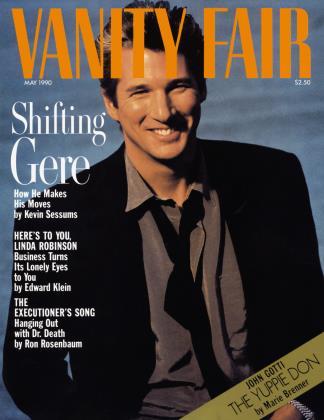Sign In to Your Account
Subscribers have complete access to the archive.
Sign In Not a Subscriber?Join NowBUBBLE HEADS
They're reinventing champagne in California
JOEL L. FLEISHMAN
Wine
California wine enthusiasts, and even some Napa and Sonoma vintners, are defensive about the qualities of California sparkling wines. They struggle to differentiate them from the French product, as they have done with Cabernets and Chardonnays, on such grounds I as style ("forward and bold" Califomias versus "elegant and balanced" French). It was with these distinctions in mind that we recently set up a blind tasting of sixty-eight French, American, and Spanish sparkling wines, divided by price level into seven flights. But there were some surprises in store, chief among them that there are no style differences worth noting between California and France. The major California entries were fully equal to the French head-to-head.
To understand just how far California sparkling-wine-making has come, consider these results. In one flight of ten wines, two tied for first place in the group ranking, with markedly higher scores than the other eight: BillecartSalmon Brut from France and the 1986 Schramsberg Blanc de Blancs from the Napa Valley. Not far behind those pacesetters were the French Veuve Clicquot Brut and the 1986 Iron Horse Brut from Sonoma County. In another flight, my top two choices out of ten were Pol Roger's 1982 Blanc de Chardonnay from France and the 1982 Schramsberg Reserve from California. In yet another flight, this one of nine wines, Mumm Cordon Rouge from France was my favorite, closely followed by the 1982 Piper Sonoma Brut Reserve from California.
Such results might seem a consequence of the labors of the French champagne artists who work in California, either for their companies' American branches or for local wineries, but that explanation is more or less irrelevant, because the grapes are, after all, grown in California, and it was the California soil and climate—not the winemakers— which were said to be totally unsuited for the production of elegant and balanced wine. Moreover, despite the remarkable achievements of French sparkling-wine-making in California, our tasting indicates that the greatest of the American bubblies are produced not by French vintners or corporate conglomerates but by Schramsberg and Iron Horse.
Whatever the explanation, there is surely a greater abundance than ever of dazzling sparkling wine, and here are some of our favorites.
In the lowest price category, I have to give the edge to the slightly yeasty, nicely balanced Mumm's Cuvee Napa ($15). But it is only an edge, because the citrusy 1986 Piper Sonoma Brut ($15) is also superb, although perhaps lacking enough yeastiness for character, and not quite as deep as the Mumm. Those who like more yeastiness in sparkling wines will prefer the 1984 Iron Horse Late Disgorged Brut ($24), a masterpiece of the pleasantly pungent style. The frothy, refreshing 1984 Schramsberg Blanc de Noirs ($22) has deep yeasty flavors, too, but they are softened by hints of green apple and citrus.
Among the slightly more expensive wines, these stood out: the beautifully balanced Billecart-Salmon Brut ($25), with lemon/apple flavors and a rich but sedate mousse; the appley 1986 Schramsberg Blanc de Blancs ($23); the frothy Veuve Clicquot Brut ($28), with its hints of apple and lemon and a slight cinnamon edge; the toasty 1986 Iron Horse Brut ($22); the elegant Moet & Chandon Brut Imperial ($23); the Charles Heidsieck Brut Reserve ($26), with its lemon, apple, and mild tobacco flavors; and Taittinger's full, round Brut La Frangaise ($27).
Moving on up the price scale, I found the 1982 Pol Roger Blanc de Chardonnay ($40) one of the most impressive wines at any price. It has all the essentials of a great sparkler: beautifully rounded, vigorous mousse; dazzling balance of sweet apple, lemon, dry toast, and pungent yeast flavors; character with elegance from First sniff through crisp, refreshing, dry finish. Almost of that quality is the slightly less robust 1982 Schramsberg Reserve ($30). In roughly the same price range, other standouts were the 1983 Bricout Brut ($22), the 1985 Perrier-Jouet Brut ($30), Mumm Cordon Rouge ($30), Piper Sonoma's 1982 Brut Reserve ($23), the 1983 Louis Roederer Brut ($40), and Moet & Chandon's 1985 Brut Imperial ($35).
Among the eighteen superpremium entries, ranging in price from about $46 to $125, those which showed best were the elegant 1982 Dom Perignon ($85), with its breathtakingly light mousse full of bubbles, and dry, sweet, citrus, apple, yeast, and toast flavors; the decidedly dry, toasty 1979 Laurent Perrier Grand Siecle ($80); Deutz's 1982 Cuvee William Deutz ($60), with spicy apple and lemon flavors and a near-perfect balance of toast and yeast; the fullflavored 1982 Perrier-Jouet Fleur de Champagne ($65); the yeasty yet light 1982 Salon Le Mesnil ($125); Veuve Clicquot's delicate 1983 La Grande Dame ($70); the powerful Krug Grande Cuvee ($80), with its dry, vigorous mousse and yeast and lemon flavors; and the gorgeous 1982 Bricout Elegance ($46), toasty, yeasty, lemony, balanced.
 View Full Issue
View Full Issue


















Subscribers have complete access to the archive.
Sign In Not a Subscriber?Join Now